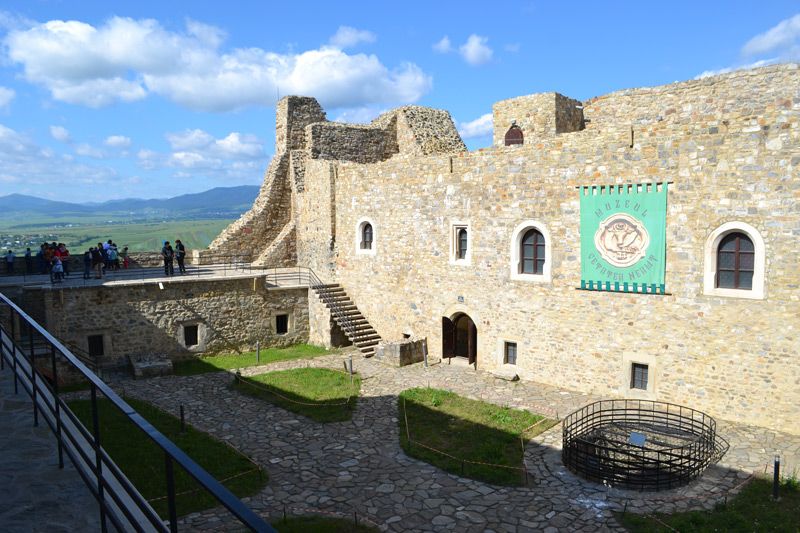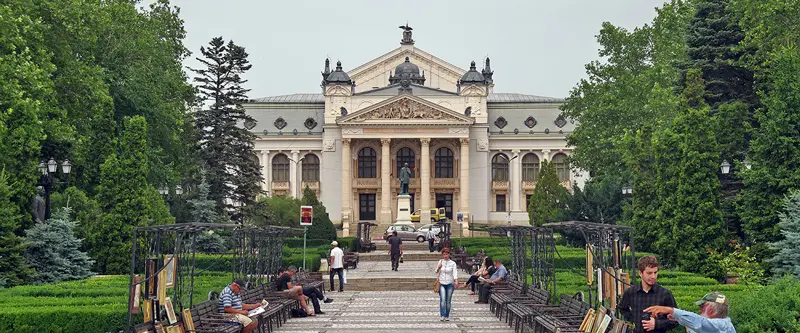Chapters
Once, it was one of the mightiest fortifications of the Moldavian medieval state, and then it remained in ruins for hundreds of years. Since 2015, Neamt Citadel has been restored and included as a historical monument of Neamt County.
The fortress located in the northeastern part of Romania sits on the Timus Rock of the Plesu Peak (also called the Fortress Hill), at an altitude of 480 m. Its purpose was to guard the valley of Moldova and Siret, and the road that crossed the mountains in Transylvania.
The Rise of Neamt Fortress
Before the archeological researches made on the Neamt Citadel in the 20th century, it was commonly believed that the Teutonic Knights founded the fortress between 1211-1225. However, the study showed that the fortification was built in the 14th century Moldavia during the reign of Petru I Musat and was expanded in the 15th century.
The results of the archaeological research showed several stages of the construction of the fortress. No previous fortifications have been identified, resulting in the first fortified construction dating from the time of the reign of Petru Mușat. The coins discovered on site also showed that the Neamt Fortress was built during the second part of the reign of Peter I, in a period in which Moldova underwent continuous economic and political development.
The fortress played a significant role in Stephen III of Moldavia’s defence system, along with Suceava, Soroca, Tighina, Orhei, Hotin, Chilia, and Cetatea Alba. He understood best the need of building fortified buildings to defend the Principality of Moldavia from the attacks of the Turks, Tatars, Hungarians or Poles.
The legendary prince built the first fortified monasteries (religious sites like Agapia Monastery) in Moldova and strengthened the existing fortresses. Stephen III didn’t consider that the Neamt Fortress is sufficiently strong to withstand the attacks of his enemies. So, he ordered the walls of the fortress to be raised by about 6-7 m and the construction of narrow skylights and windows through which the defenders of the fort could watch and strike the enemies.

On the northern side of the fortress was built a wall flanked by four semicircular bastions with thick and resistant walls, with variable heights, up to 30 meters, giving an outer courtyard to the citadel.
To prevent the enemy soldiers from getting closer to the walls, Stephen the Great ordered the digging of a defense ditch much deeper and broader than the previous one on the north and northeast sides of the fort.
The only access way to the fortress was by an arched bridge with a fixed part and movable part, supported on 11 stone pillars. The movable part was on the portion of the bridge between the last pillar and the wall of the bastion and could be raised in case of distress, by a system of pulleys. If the enemy would manage to get past the bridge, there were two traps, known as “mousetraps.”
Not long after Stephen III strengthened Neamt Citadel, it went through the trial of war being besieged by Mahomed II. Mahomed II besieged Neamt Fortress for eight days using 7 Turkish Great Bombards to bomb the walls. Even with their legendary firepower, the Turks couldn’t manage to bring down the walls of the fortress. The fire returned by the artillery from inside the fortress was too much of a hassle, so after losing 2 bombards and his artillery commander, Mahomed, had to abandon the siege.

The Fall of Neamt Citadel
After the end of Stephen the Great, no significant improvement was brought to the citadel. For many years, the fortress had been abandoned until the prince Vasile Lupu repaired it in the 17th century. In wartime, prince Vasile used it as a place of refuge for his family and assets.
But in the 17th century, the Polish incursions in Moldavia increased as well, and it led to numerous conflicts between Moldavians and poles, and Turks and poles, which came to an end at the beginning of the 18th century. Once the Poles stood out of the region, the Austrian started their incursions, and because the Austrian expeditionary forces kept taking cover in the fortified monasteries and citadels, the Ottomans demanded prince Mihai Racovita in 1718 to demolish Miera Monastery and Neamt Citadel.
After the prince ordered its destruction, the fortress lost its political and military importance and entered a state of decay emphasized in the years to come by the ignorance of Phanariot rulers and Targu Neamt dwellers taking stones to build houses and cellars.

The Rehabilitation
Fortunately, in the 19th century, Prince Mihail Sturdza issued several royal decrees by which he demanded the protection of the walls with a fence and the placement of a supervisor. Also during his reign, an access path to the fortress was arranged.
Starting from the middle of the 19th century, the Neamț Fortress became a symbol of the glorious history of the Romanian people. In 1866, the Neamț Fortress was declared a historical monument, and during 1968-1972, wall consolidation works were commissioned. During 2007-2009, the Fortress of Neamt was rehabilitated with European funds and placed back into the national and international tourist circuit on July 4, 2009.
21 rooms were arranged, including the counseling and trial room, the weapons room, the prison, the provision room, the dining room, and the chapel. In some rooms, the atmosphere of the past, when the fortress was inhabited, is recreated.

Description
Nowadays, after the renovation, Neamt Citadel looks mostly how it should have in the past and consists mainly of original materials (river stone, quarry stone, and green sandstone). Between the fortress and the rest of the plateau, there is great defense ditch, on the northern side, and the fort can be reached only through the 11 pillars bent bridge.
The fortress is shaped like a quadrilateral with uneven sides; the north side is 38.50 m, the south side 37.50 m, the east side 47 m and the west side 40 m. The walls are about 3 m thick and initially had a height of about 12-15 m, being supported and reinforced on the outside by 18 strong prismatic-shaped buttresses. The citadel has 4 defence towers on its corners and a large inner courtyard in the middle, courtyard, surrounded by rooms with different uses.

How to get to Neamt Citadel
If you want to visit Neamt Citadel, you should be landing on Iasi International Airport and have a drive of 112 km, which takes around 2 hours. However, if you get to go in the Targu Neamt Area, it would be a shame not to take the opportunity to visit Agapia Monastery and Bison Land.
Take a look at our private day trip from Iasi to Neamt or, if you have something else in mind, we can arrange for a custom tour.
Wish you a safe trip!





